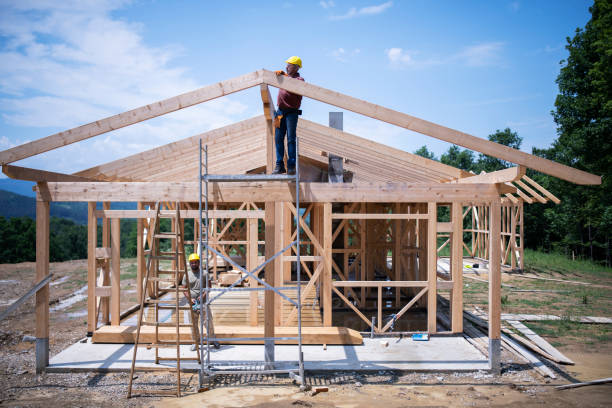25 Steps You Can’t Miss as a Construction Builder
Are you a builder who is constructing a new property? Start strong by getting a construction loan for your project and by following these 25 steps for construction success. You can still schedule your construction project well without meeting some of these principles, but for each one you skip, it makes having a predictable outcome more difficult.
1. Adopt simplification as a daily company mantra, no matter the size or type of product.
Simplification is not just the domain of the box-on-box production units; it applies equally to large custom homes and everything in between. Whether product or process, eliminating excess steps, paperwork, approvals, materials, or trips makes scheduling far easier.
2. Develop a thorough “construction start requirements” checklist
Do this for each project and follow it religiously. This covers everything that must be done at a project site before you dig so the house has a fighting chance to stay on schedule — undergrounds, grading, lot/pad prep, lot-fit analysis, permits, etc.
3. Include “meet customer” activities in the schedule, including pre-build, pre-drywall, and orientation.
Don’t pretend that these critical activities don’t take time or can simply be scheduled on the fly. Careful management of the customer relationship and what goes into their home avoids changes that can upset the schedule.
4. Recruit suppliers and trades that understand that a fast, consistent schedule is in their best interest.
Sure, some won’t get it, but most can understand that a predictable schedule with long lead times makes everything they do easier and allows them to stay on time for you. The prospect of getting paid more quickly is usually enough motivation.
5. Establish clear scopes of work for each supplier and trade with job-ready and job-complete definitions.
Every single item and how it is done should show up on someone’s scope, as should a clear definition of “job complete.” If not, things get missed and the chain of phone calls, extra trips, and trades on top of other trades begin. The schedule suffers.
6. Develop your construction schedule with input from each supplier and trade, with realistic allowances for weather, holidays, etc.
If you’re in Fargo, N.D., don’t pretend you have the same number of workdays in February that you do in July. If you’re in Michigan, be a realist and take two days out in November for deer hunting season. Never schedule construction beyond the capacity of the workforce, and you must build a relationship where your trades are completely honest with you. Getting them involved gets buy-in.
7. All units, regardless of size, should be built on the same schedule, with specific tasks completed on specific days.
For instance, framing during construction always begins on day 12. Insulation goes in on day 30. Flooring begins on day 49 — every house, every time (note: sample numbers only). While controversial, this is the ideal. Sure, you will have down days on your smaller plans, but overall, your schedule will dramatically improve and shorten. The goal is total predictability.
8. Adapt crew sizes to your construction schedule. Never schedule based on crew size and availability.
As a construction builder and/or manager, you already know the importance of preparing for the job. This also goes for crew size to schedule ratios. An 1800-square-foot ranch might take a four-man framing crew five days. To frame a 3,000-square-foot, two-story house, you may need a crew of eight to meet that same five-day schedule window. Find trades who can adapt and give them steady business.
9. Establish a system for weather events and other contingencies.
The goal is to keep the entire system working in harmony, maintaining flow and predictability throughout the process. If a weather event occurs, move all houses back a day (or whatever is required). By doing so, you just eliminated overlaps and trade conflicts. Every space launch builds in automatic holds to cushion delays. Most get used, but the launch is still “on time.”
10. Value-engineer all plans based on Lean design principles prior to starting.
The goal is to have as close to the exact material requirements delivered to the house as possible, with no excess supply or shortages—no TJIs to pick up, no cubes of brick left over, no sheets of OSB for a hot-shot run. Every single incident compromises the schedule.
11. Use manufactured components whenever available and cost-effective, including trusses, panels, and off-site sub-assemblies.
Manufactured components are quicker to install, saving schedule days that can most often make up for any additional cost (if all the factors are calculated). In addition, on-site waste is reduced. Finally, having less material to climb over, work around, and pick up saves time.
12. Offer only the number of plans and elevations you can keep 100 percent current.
Most builders have way more plans than they need and seldom keep them current. That means continual phone calls, calculations, VPOs, shortages, overages, trips, and rework. Apply the 80/20 rule every year and throw out whatever is not selling.
13. Provide only the number of options customers will pay for and can be kept 100 percent current.
Options are another area where builders routinely offer far more than is needed. Again, the application of the 80/20 rule is in order. The true cost of an option includes phone calls, mistakes, rework, and a warranty. Builders seldom calculate this accurately.
14. Establish all pricing up front, whether unit pricing or base model plus options.
Whichever approach you use, know the prices you have to charge customers up front so there are no schedule delays during production. This starts with a thorough understanding of cost based on detailed takeoffs and advance negotiation with suppliers and trades.
15. Negotiate cut-off dates with sales for all selections and changes, and manage customers (and your staff) to those dates.
I have seen this done well too many times to say it cannot be done, even in this market. It takes skilled salespeople, a focused management team, and a companywide commitment. You simply cannot maintain a tight schedule without firm cut-off dates.
16. Release of construction starts evenly and maintains a schedule for each unit. The goal is even-flow.
Yes, true even-flow requires a backlog, which is difficult in a depressed market. But simply not starting multiple homes on the same day is a helpful step. Once a house is released to production, however, there is no excuse for not doing everything possible to maintain the published schedule throughout. The benefit cannot be overstated.
17. Provide the superintendent with a complete starter package for each unit with all details and options.
Other than cosmetic selections and colors, the field superintendent should have all the details for building the house on day one, in an organized, systematic package (paper or online). Breaking the builder habits of playing catch up and making it work on the fly greatly enables maintaining the schedule.
18. Maintain a comprehensive, strategic process of incoming quality control of materials.
For each new project, check loads daily, log, and provide feedback to suppliers, including lumber, concrete, shingles, and drywall. Once suppliers know you care you can back off to weekly or even monthly checks. Load checks ensure both quantity and quality are correct from the start, avoiding rework, extra trips, and schedule delays.
19. Make sure each building site is clean and orderly with a site plan for the placement of materials.
This takes vigilance, but once suppliers and trades see it they help you because it helps them. Having a plan for each lot where materials are dropped can make a significant difference. An out-of-control site means an out-of-control schedule.
20. The standard for the field superintendent is “be in each house, each day.”
Until the schedule runs like clockwork, daily monitoring of each site is essential for any builder.
21. Shorter cycle times increase “turns,” which accelerate the absorption of fixed costs, leading to higher profit.
When fewer units overlap, field supervision is far easier. Tell a superintendent handling 20 units on a 120-day schedule that you are cutting it to 90 days and he will panic. However, tell him that he will only have to manage 15 units simultaneously and he’ll be happy. Remember, complexity increases exponentially, not arithmetically.
22. Maintain a clean construction worksite.
Each house should be left broom-clean, each day, allowing each trade easy access and full accountability. This is a test. If you don’t understand how this impacts the schedule, go back to “GO” and do not collect $200. Any job gets dramatically easier and control is better maintained with a clean worksite.
23. Maintain a visual “at-a-glance” schedule board with daily status on each unit under production.
This is by far the best approach, and whether you use the “string line,” the “horse race,” or some other method, a good system will show where each house is on the schedule and how well it’s running. Many of our whiz-bang computerized systems can’t do this nearly as well as a large whiteboard with lines, markers, and magnets.
24. Always pay on time, consistent with the schedule.
But only pay for work completed 100 percent to scope. The definition of a completed job is “100 percent to scope, on time, with no rework and no waste.” When trades know that within a few days of meeting that standard they get their money you get their full commitment and their best crews. This will pay you back 10 times for anything you think you are saving on “float.”
25. Find the best suppliers and crews using total cost, not bid price alone, and negotiate for the best crews.
These days, the cost of every item in a home is critical. But if you use bid price alone you will forgo profit, every time. Not all crews are the same. The builder who consistently gets the best crews will run the best schedule and produce the best house at the greatest profit. But you have to earn it. Becoming the best scheduler in town will get you there in a hurry.
More Than Just the Schedule
There is a bit of a trick to this list. On the surface, it is all about scheduling, and I hope you are convinced that assuming you build a great product that people want to buy, scheduling is synonymous with profit. But running a great schedule requires so much more than what we typically think of at first consideration. Thus, this is really a list of “best operating practices.” You will find, though, that keeping your focus on schedule will drive all of it. Remember that we’re not suggesting you build simple homes with zero great marketing features. We’re asking you to never forget that increased variation in a process has an exponential impact and to understand the systems implication and the consequences, especially for the field. Double your options and you do not double complexity—you quadruple it.
Ford is building great trucks with great quality at a fair price these days, and obviously, as their sales numbers show, it’s a product that people want. You cannot, however, get anything you want in a Ford truck. Yet 100 percent of the customers can get a huge measure of what they want, and probably 99 percent get what they need. Ford has worked hard to achieve this status through understanding customer requirements and then relentless application of Lean process and methods. They built the systems to keep the variation and all of their processes under control. Have you? You need to get there, and a schedule is the best place to start.
By Scott Sedam


